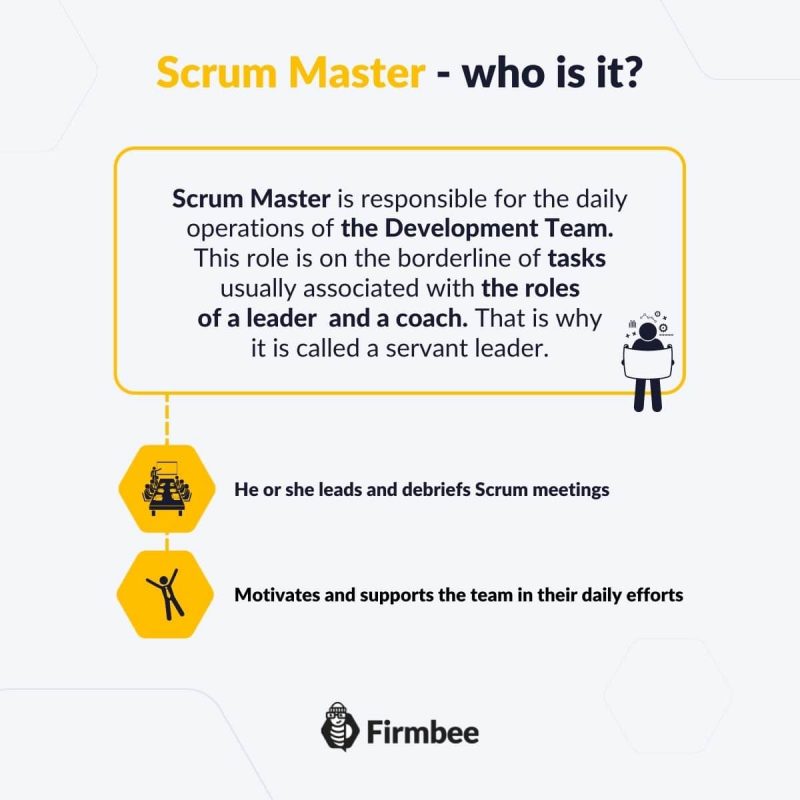In the previous articles about Scrum, we explained who makes up the Scrum Team. We already discussed the Product Owner, so today it’s time to introduce who is the Scrum Master. If you would like to understand that position and its role in the Scrum Team, take a minute and read on!
Scrum Master – table of contents:
Who is the Scrum Master?
Scrum Master is responsible for the daily operations of the Development Team. This role is on the borderline of tasks usually associated with the roles of a leader and a coach. That is why it is called a servant leader.
At first glance, it might seem that Scrum Master is just an odd name for a project manager, i.e., the person who makes sure that the team members have all the skills necessary to achieve the goal.

Servant leader
First, a project manager in traditionally managed organizations is expected to withdraw from the team after checking that everything is in order. He/she will come back after the agreed time to check if the tasks are done. This is not the case with the Scrum Master.
The Scrum Master works with the team at all times. Just like the Product Owners, Scrum Masters are irreplaceable and ever-present members of the Scrum Team and their participation in the daily work is essential. It is their job to maintain the morale of the team.
The second issue that strongly distinguishes a project manager from the Scrum master is the issue of solving the problems encountered during teamwork. In the traditional approach, the team should deal with them by itself. In Scrum, on the other hand, if there are problems, the development team should ask for help from the Scrum Master. Here, this role is most closely similar to the one of a coach.
The Scrum Master is also a coach when building the motivation of the whole Development Team and each individual. One of the Scrum Master’s key tasks is to encourage individual team members to develop themselves. He/she can point out skills that are worth improving or suggest new, interesting development paths. First, he/she can recommend new captivating development paths, especially the ones that increase the interdisciplinary character of the team. Expanding the competencies is aimed at increasing the effectiveness and harmony of the Scrum Team, which results in greater internal controllability and better self-management capabilities.
The Scrum Master’s task, which is worth mentioning here, is also keeping the team focused on task execution. And, closely related to that, protecting the team from the influx of external tasks. If the Scrum Team works as a part of a bigger organization, its work may be disturbed by the urgent needs of other units. It is the Scrum Master’s job to explain to others that it is not good to disturb the Scrum Team’s work rhythm.
Keeper of Scrum
The key competence of a Scrum Master is an excellent knowledge of Scrum principles. And the key task – making sure that Scrum recommendations are followed. It helps all individuals to understand the theory and practice of Scrum.
An important part of the Scrum Master’s duties is to present the Scrum Team’s way of working to the Customer and other Stakeholders. This is often the key to achieving the Product Goal. The Customer needs to be aware that in Scrum, as in other agile methodologies, continuous collaboration with the Customer is more indispensable than contract negotiations. This means, among other things, consulting the Product Owner about the project priorities instead of preparing the specification once.
Since the Scrum Masters are the guardians of Scrum, they can also be its evangelist in the organization. However, their tasks primarily involve training the team members.
Scrum Masters make sure that the Scrum rules are clear and understandable to everyone in the Scrum Team. They are also responsible for all the scrum events to take place, which we’ll cover in a separate article. What’s more, it is also the Scrum Master’s job to moderate these meetings, monitor their productivity and ensure they stay within the designated timeframes. The key role is to support the team in reaching the Goal. In other words, to make all meetings constructive and productive.

What does a scrum master do? Summary
So who is the Scrum Master? He/she is a servant leader: a master of Scrum, a manager, and a coach all in one. While it may seem like a breakneck task to reconcile all of these roles, the scope of the Scrum Master is surprisingly consistent.
To help in the smooth functioning of the Scrum Team and also moderate the daily and periodic scrum meetings and ensure that they run smoothly. To protects the distinctiveness of the team and facilitate the individual development of its members. With excellent knowledge of Scrum principles, the Scrum Master trains others in its functioning.
What other qualities and skills should a good Scrum Master have? You can read about them in the next article we’ve prepared covering the Scrum methodology.
If you like our content, join our busy bees community on Facebook, Twitter, LinkedIn, Instagram, YouTube.
Author: Caroline Becker
As a Project Manager, Caroline is an expert in finding new methods to design the best workflows and optimize processes. Her organizational skills and ability to work under time pressure make her the best person to turn complicated projects into reality.
Scrum Guide:
- Glossary of basic terms, roles and notions
- What is Scrum?
- Scrum values
- How to implement Scrum in your company?
- Scrum Team - what is it and how does it work?
- Who is a Product Owner?
- The most common mistakes of Product Owner
- Who is the Scrum Master?
- Characteristics of a good Scrum Master
- The most common mistakes of Scrum Master
- What statistics and metrics should the Scrum Master track?
- Cooperation between Product Owner and Scrum Master
- Development Team in Scrum
- The most common mistakes of Developers
- Scrum artifacts
- Scaling Scrum
- Sprint Backlog
- What is the Product Backlog?
- What are User Stories?
- Creating the best User Story with INVEST
- The most common User Story mistakes
- User Story Acceptance Criteria
- Estimation and Story Points in Scrum
- Planning Poker
- Team Estimation Game
- Defining Increment
- Scrum events
- What is Sprint in Scrum?
- Scrum Team Commitments - Product Goal, Sprint Goal and Definition of Completion
- What is a Burndown Chart?
- How to create and interpret a burndown chart?
- Advantages and disadvantages of the burndown chart
- Kanban boards in Scrum and Scrumban
- Velocity in Scrum - Speed of the Development Team
- Daily Scrum
- Sprint Planning
- Sprint Review
- What is a Sprint Retrospective?
- Common mistakes during a Sprint Retrospective
- Product Backlog nurturing


















